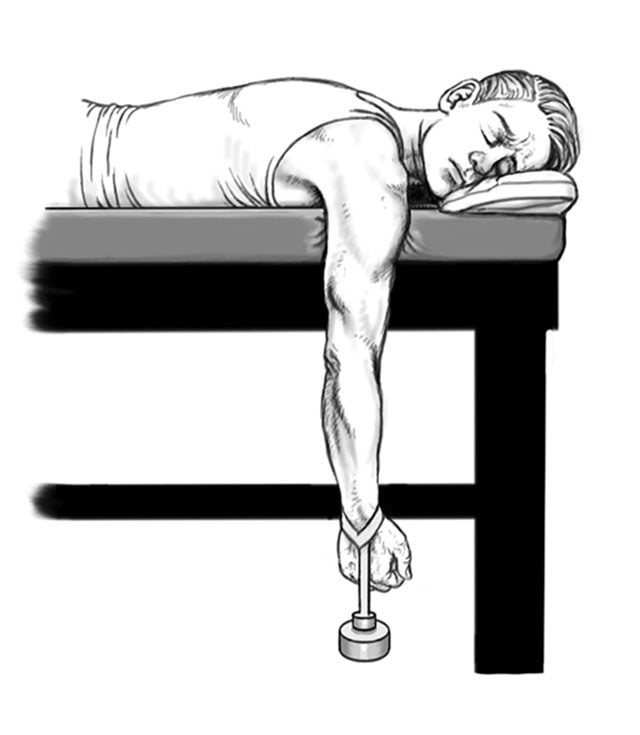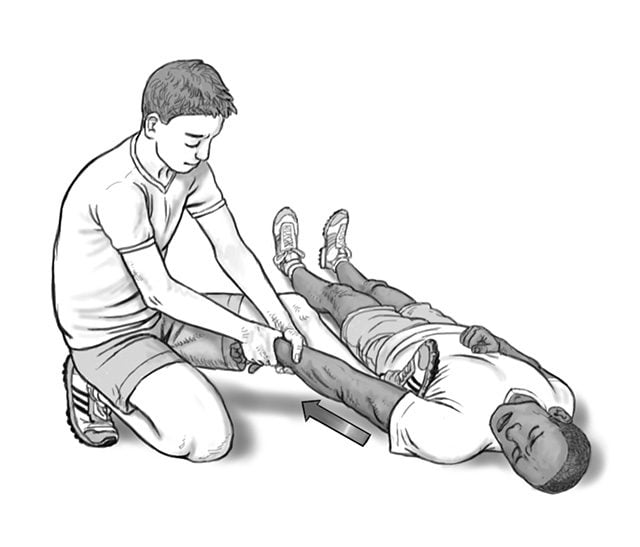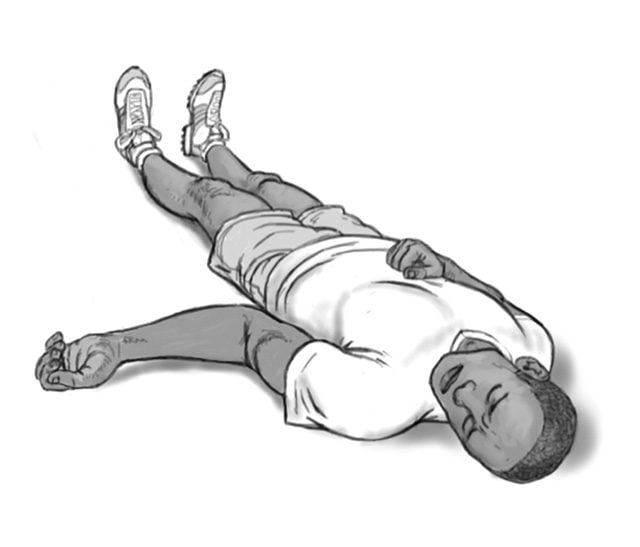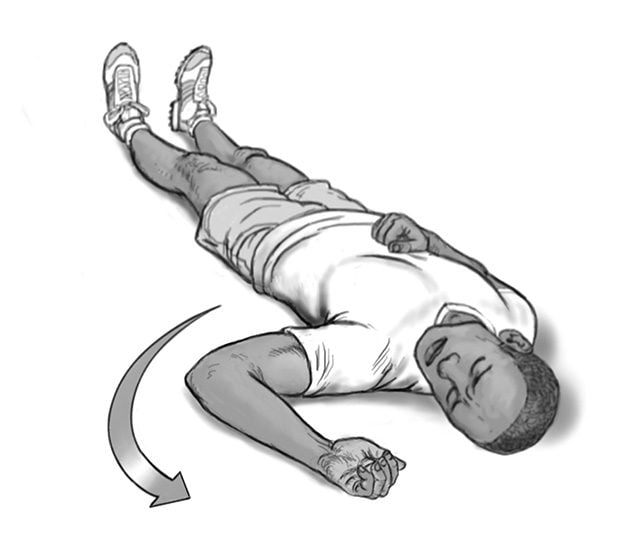How to Treat a Dislocated Shoulder Without a Doctor
Updated: Sep. 10, 2019

Simple ways to pop a shoulder into place without doing more harm than good, according to a survival medicine expert.
Our editors and experts handpick every product we feature. We may earn a commission from your purchases.
James Hubbard, MD, is a family doctor and author of The Survival Doctor’s Complete Handbook.
[Note: If someone has an injured shoulder and you suspect the joint is dislocated, seek medical attention immediately. Under ordinary circumstances, you should not attempt to push the shoulder joint back into place as you may cause additional injury to the joint, muscles, blood vessels, or nerves.]
You’re slipping down a hill and grab a tree limb to stop yourself. A nice way to break a fall. But a good way to dislocate your shoulder.
Shoulder dislocations usually occur when you grab something over your head while your full body weight is being pulled downward, or when you break a forward fall with your outstretched arm. Since the shoulder is a ball-and-socket joint, if the ball gets jerked out of the socket and doesn’t go straight back in, muscles and ligaments pull it back tight against the side of the lip of the socket. And there it’s stuck.
For the treatment, well, think about trying to put a ball into a cup. If the ball is stuck tight to the outside part of the cup, there’s no way to get it back in without unsticking the ball or breaking the cup. And if you have a dislocated shoulder, you sure don’t want to break the cup.
(Looking for a good survival story? Check out this story of a solo hiker who was unable to move after a gruesome fall.)
How to diagnose a dislocated shoulder
Sometimes a dislocation isn’t visually obvious, even when you compare the injured side to the noninjured side. But if someone’s shoulder is hurting and is hard to move, the cause of the injury can give you a clue about whether it’s dislocated.
If you’re unsure, have the victim touch the opposite shoulder with the fingers on his injured side. Someone with a shoulder dislocation won’t be able to do this. Of course, someone with a break or just a bruise may not be able to do this, either, but if the victim can do it, there’s no dislocation. These life-saving survival skills might also be useful someday.
Dislocated shoulder treatment: Do no harm
The best way to try to get the joint back in place is to find a way for those shoulder muscles and ligaments to relax just enough so the head of the humerus can slip over the rim of the shoulder cup and back into position. Yeah—easier said than done.
Injured muscles tend to spasm. With time they swell and stiffen even more. So in general, the quicker the joint is put back into place the easier it is to do. However, without an X-ray, dislocation or not, you really can’t tell if a bone is broken or, if so, how badly. So remember the first axiom of treatment: Do no harm. Never force anything.
Until you can get expert care, place the arm in a sling for comfort and apply ice packs or just hold the arm. If help is not going to be available soon, you could try one of the following three treatment options. Even if they work, you should keep the arm in a sling for several weeks, gradually moving and getting range of motion back while giving the muscles and ligaments time to heal. Don’t miss these everyday fixes to survive basically everything.

Dislocated shoulder treatment option 1: Arm hang
This is the simplest method, with the least chance of additional injury.
- Have the injured person lie facedown on a table, bed, or something else high enough for the arm to hang off the side without touching the floor. The entire arm should hang straight down from the injured shoulder.
- Tape or wrap a weight, ideally approximately 15 pounds, to the hand or lower arm. (A gallon of water is about eight pounds.) Having the victim hold the weight in his hand doesn’t work nearly as well, because to grip an object, you have to tense some muscles.
Soon, the victim should start to relax a bit, realizing that this procedure is not causing any additional pain. As the muscles relax, the head of the humerus will drop below the rim of the socket enough to snap back into place. Usually, the victim will hear or feel a soft pop or just experience a sudden relief of pain, but sometimes it’s too gradual to sense.
If you’re uncertain about whether the treatment has worked, take the weight off after about 20 minutes and see if the victim can touch his fingers to the opposite shoulder. If he can, the joint is back in place.

Dislocated shoulder treatment option 2: Arm pull
- Have the victim lie on his back on a firm surface.
- Slowly guide the arm on the injured side horizontally away from the body until it’s about forty-five degrees from his side. Never force.
- Grab the hand and pull it toward you firmly and steadily, staying in that forty-five-degree angle. You’re trying to get the muscle to give just enough that the head of the humerus moves beyond the lip of the shoulder cup. If you need a little leverage, use your foot to push against the victim’s side, as shown in the illustration.
Dislocated shoulder treatment option 3: Arm rotation
This method produces some strong torque—enough to actually break a bone. So never jerk. Never force. And only use this option if expert help will be unavailable for days.

- While the victim is lying on his back on a firm surface with his injured arm close to his body, slowly and gently rotate the forearm until the hand is face up.

- While keeping the humerus (upper arm) fairly close to the side of the body, bend the arm at the elbow and rotate the forearm to the side until it’s at a 90-degree angle relative to the upper arm. It should still be on the ground or table (or close to it).

- Keeping the elbow at this angle, move the humerus away from the body and toward the head until the hand is a little above the height of the head and the humerus is at a ninety-degree angle relative to the chest. It will look as if the victim is about to pitch a baseball.
- Continuing to keep the elbow flexed and locked, move the forearm above the head, resting it on top of the head.
If this doesn’t work, you’ve given it your best shot, so just reposition the arm however it’s most comfortable. Place it in a sling, too, if that helps. Maybe try again after some pain medicine.
Some claim that if a person with a dislocated shoulder can just relax enough (a lot) and let the arm hang down while he’s standing, the muscles will loosen enough for the shoulder to go back into place on its own. It’s worth a try, but I find most people can’t relax that much when they’re in pain. Maybe you can.
One method I would never try is going all Rambo and banging your shoulder against a wall or tree. Yeah, I’ve heard some people claim it works. But you’re likely to do more harm than good.
Make sure you’re prepared for anything with these six proven skills to survive any emergency.

The Survival Doctor’s Complete Handbook by James Hubbard will take you step-by-step through the essentials of medical care during an emergency. Maybe you live alone in a rural area, or you just want to make sure you and your family are prepared to safely weather the next natural disaster. Whatever your situation and your health needs, The Survival Doctor’s Complete Handbook is your must-have medical resource.



















